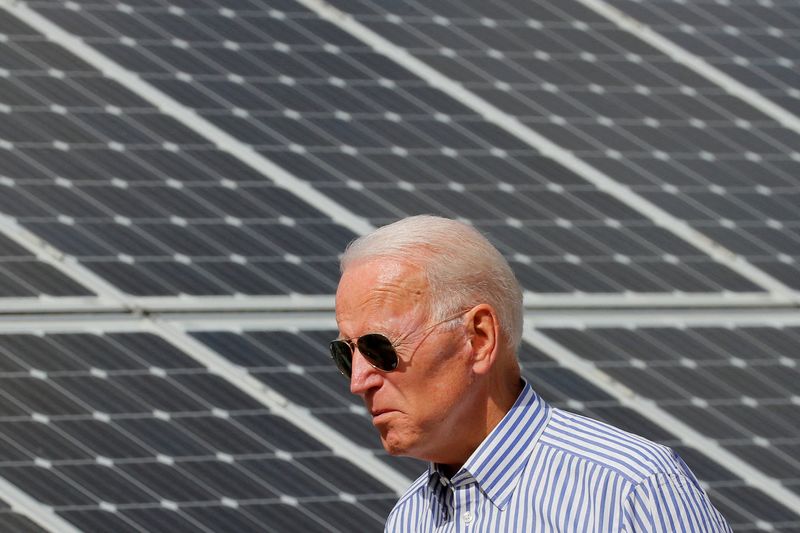By Valerie Volcovici
WASHINGTON (Reuters) -The Biden administration on Thursday unveiled a sweeping plan to slash greenhouse gas emissions from the U.S. power industry, one of the biggest steps so far in its effort to decarbonize the economy to fight climate change.
The proposal would limit how much carbon dioxide power plants, which are the source of more than a quarter of U.S. emissions, can chuff into the atmosphere, putting the industry on a years-long course to install billions of dollars of new equipment or shut down.
Environmental groups and scientists have long argued that such steps are crucial to curb global warming, but fossil fuel-producing states argue that they represent government overreach and threaten to destabilize the electric grid.
The proposal sets standards that would push power companies to install carbon capture equipment (CCS) that can siphon the CO2 from a plant’s smokestack before it reaches the atmosphere, or use super-low-emissions hydrogen as a fuel.
The Environmental Protection Agency projects the plan would cut carbon emissions from coal plants and new gas plants by 617 million tonnes between 2028 and 2042, the equivalent of reducing the annual emissions of 137 million passenger vehicles.
"Today we're proposing new technology standards that will significantly reduce greenhouse gas emissions from fossil fuel power plants, protecting health and protecting our planet," EPA Administrator Michael Regan told students at the University of Maryland on their last day of school on Thursday.
Regan said that the agency has wielded the power of the federal Clean Air Act to craft the new power plant rules, along with a suite of other measures aimed at tackling vehicle emissions, as well as potent greenhouse gases methane and HFCs, that would reduce the equivalent of 15 billion tonnes of greenhouse gas emissions between 2022 and 2055.
White House climate adviser Ali Zaidi told reporters the proposal will keep the U.S. on track to meet its goal to achieve net-zero power sector emissions by 2035.
"When you look at what is in the rule and what is proposed we are absolutely in line with the president's goal," he said.
FIGHTING 'FEDERAL OVERREACH'
The proposal, more than 18 months in the making, reflects constraints imposed on the EPA by the Supreme Court, which ruled last year that the agency cannot impose a system-wide shift from fossil fuels to renewable energy, but can regulate plants by setting technology-based standards applied on-site.
An effort by the administration of Democratic former President Barack Obama in 2015 to broadly slash power industry emissions was hung up by legal challenges and eventually repealed in 2019 under the administration of Republican President Donald Trump. The Trump's own scaled down power plant rules were also scuppered by courts.
West Virginia Attorney General Patrick Morrisey, who led the legal challenge against the previous EPA carbon rule, said in a statement that the coal-producing state will "be ready once again to lead the charge in the fight against federal overreach" and said the proposal "just seems designed to scare more coal-fired power plants into retirement."
West Virginia Democratic Senator Joe Manchin on Wednesday threatened to block all EPA nominees because of the impact he said the rules will have on coal.
The proposal is subject to the regulatory rule-making process, including a public comment period. The final rule will have to reflect the public comments and will likely take about a year to be finalized.
The agency and research groups said the proposal reflects the current trends in the power sector, which has seen a decline in coal capacity from 321 gigawatts (GW) to 219 GW from 2005 to 2022, a surge in new renewable capacity and some utilities contemplating the use of CCS and hydrogen in their medium-term plans.
“This standard will further support a transition already underway that is being driven by the compelling economics of clean energy, ushering in a reliable, affordable renewable electricity system for all," said Mark Dyson, carbon free electricity director at RMI.
The EPA anticipates the proposal will cost the power industry over $10 billion, while yielding health and climate benefits of around $85 billion.
It said the Inflation Reduction Act, President Joe Biden's signature climate bill, will offer billions of dollars in tax incentives and credits that will bring down costs for deployment of CCS and green hydrogen, justifying its decision to base new standards on those technologies.
'NEGLIGIBLE' POWER PRICE IMPACT
According to the proposal, new and existing large natural gas plants will be expected to install CCS that removes 90% of their carbon emissions by 2035, or alternatively to co-fire with 30% hydrogen by 2032 and 96% hydrogen by 2038.
New gas-fired "peaker plants," used as backup generation, would face less stringent standards.
For existing coal plants - whose numbers have been declining in recent years - the EPA will consider their planned lifespan.
Coal plants that run past 2040, for example, will be required to install CCS technology starting in 2030, while those shutting between 2035 and 2040 would be required to co-fire with 40% gas by 2030.
Regan said the EPA is planning to see some early retirements of older plants as a result of the proposals, but said the impact on electricity prices will be "negligible.”
Industry groups, however, questioned the costs.
America's Power, a group representing utilities that use coal, said the proposal "raises a number of critical legal questions, including whether EPA has the authority to force the use of technologies that are not economically or technically feasible for widespread use."

Environmental groups welcomed the proposal, saying it has been crafted carefully to weather legal fights.
“After two failed attempts to regulate the power sector’s tremendous carbon pollution load, EPA finally gets it just right with this proposal,” said Jay Duffy, litigation director for the Clean Air Task Force.